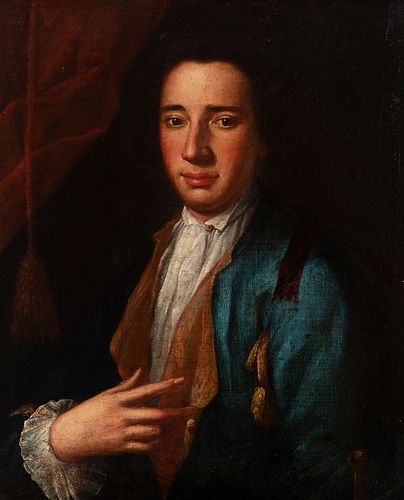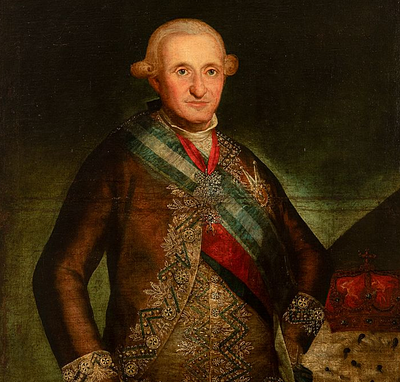Italian school; third quarter of the 18th century. "Portrait of a gentleman. Oil on canvas. Relined
Lot 31
About Seller
Setdart Auction House
Carrer Aragó 346
Barcelona
Spain
Setdart Subastas was born in 2004 and is currently the first online art auction in Spain with solidity, prestige and reliability guaranteed by our more than 60,000 users. Setdart has a young, dynamic and enterprising team ready to successfully manage the purchase and sale of art works through custom...Read more
Estimate:
EUR€3,000 - EUR€4,000
$3,125 - $4,166.67
Absentee vs Live bid
Two ways to bid:
- Leave a max absentee bid and the platform will bid on your behalf up to your maximum bid during the live auction.
- Bid live during the auction and your bids will be submitted real-time to the auctioneer.
Bid Increments
| Price | Bid Increment |
|---|---|
| EUR€0 | EUR€10 |
| EUR€200 | EUR€25 |
| EUR€500 | EUR€50 |
| EUR€1,000 | EUR€100 |
| EUR€3,000 | EUR€200 |
| EUR€5,000 | EUR€500 |
| EUR€10,000 | EUR€1,000 |
| EUR€20,000 | EUR€2,000 |
| EUR€50,000 | EUR€5,000 |
About Auction
By Setdart Auction House
Sep 22, 2021
Set Reminder
2021-09-22 09:30:00
2021-09-22 09:30:00
America/New_York
Bidsquare
Bidsquare : 22nd September - ARAS JÁUREGUI Private Collection - Old Masters, 19th & 20th Century
https://www.bidsquare.com/auctions/setdart-auction-house/22nd-september---aras-j-uregui-private-collection---old-masters-19th-20th-century-7427
ARAS JÁUREGUI Private Collection - Old Masters, 19th & 20th Century Setdart Auction House sofia@setdart.com
ARAS JÁUREGUI Private Collection - Old Masters, 19th & 20th Century Setdart Auction House sofia@setdart.com
- Lot Description
Italian school; third quarter of the 18th century. "Portrait of a gentleman. Oil on canvas. Relined It presents repainting and frame of the 19th century. Measurements; 66 x 56,5 cm; 78 x 68 cm (frame). In this portrait, the author shows us a gentleman in three quarters, slightly turned with respect to the spectator, but with his face completely in front. The young man is elegantly dressed in rich, sumptuous clothes adorned with gilt decorations, gilt buttons, lace cuffs and the large collar of the shirt, which stands out for its volumetric play. Set against a neutral, dark background, the large red curtain on the left-hand side of the composition, a legacy of Baroque portrait painting, stands out. However, the aesthetic treatment of the sitter indicates that this is a portrait that follows the precepts of neoclassicism, not only in the clothing and the type of hairstyle. It is also the aesthetics of a polished finish, in which great importance is given to detail, and which is emphasised by the use of bright tones. The surface of the work is flat, playing with a precise, meticulous use of brushstrokes. This is based on a great skill in drawing, which gains prominence over colour. An example of this is the use of a measured palette, without great stridency, in which the author has sought a balance between the different tonalities. Another common feature, typical of the portraits of this period, and which is reflected in this particular work, is the interest in capturing reality, truthfully reflecting the features of the sitter, but without leaving aside idealisation, so that we see an effigy with soft, rounded and friendly forms. Despite the above, the lack of anecdotal elements prevents us from defining who the protagonist of the scene is; however, the gesture he makes is very striking, as he adopts the pose of blessing with his right hand, which adds to the uncertainty as to the identity of the person portrayed. The work is to some extent close to the aesthetic, or style, of Giacomo Ceruti (Milan, 1698-1767), also known as the "Pittocchetto", who became one of the leading lights of the late European Baroque period. His work also reflects a certain closeness to the characteristics of the work of Pompeo Batoni (Luca, 1708 - Rome, 1787), who achieved international fame and was recognised as the best Italian painter thanks to his portraits.
- Shipping Info
-
In-house shipping available. Please inquire at admin@setdart.com.
-
- Buyer's Premium



 EUR
EUR CAD
CAD AUD
AUD GBP
GBP MXN
MXN HKD
HKD CNY
CNY MYR
MYR SEK
SEK SGD
SGD CHF
CHF THB
THB
















